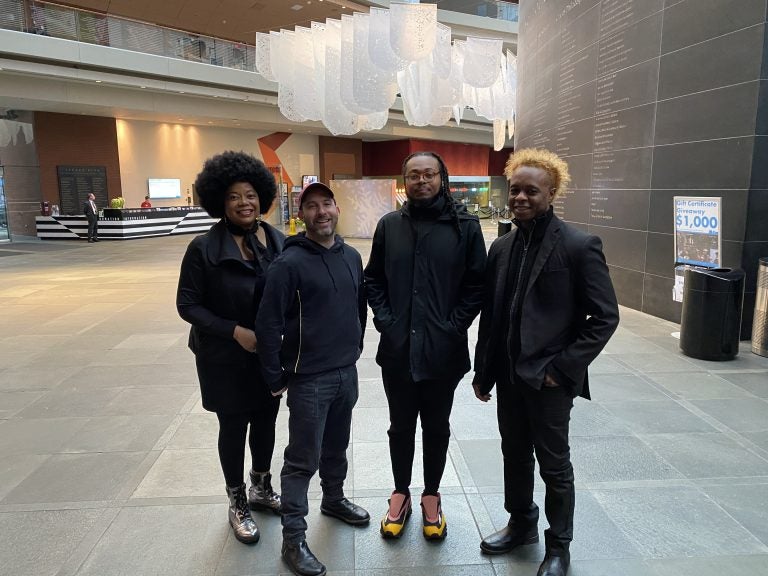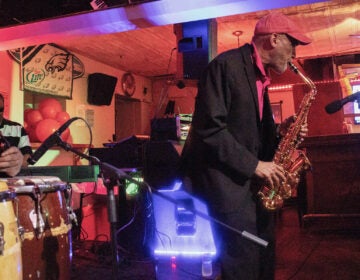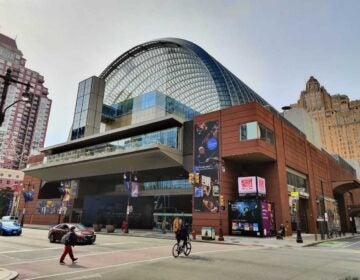Kimmel Center introduces new jazz residents
Three musicians will spend six months at the Kimmel Center to make new work.

The Kimmel Center's 19/20 Season Jazz Residents: (L-R) Ruth Naomi Floyd (vocalist composer), Jay Wahl (producing artistic director of the Kimmel Center), Immanuel Wilkins (saxophonist and composer), Richard Hill (bassist and composer) (Courtesy of Kimmel Center)
The Kimmel Center started its Jazz Residency program seven years ago to offer musicians the time, space and resources to make new work.
The program also is designed to force musicians outside their comfort zones, to try something risky and unknown. During the next six months, the selected musicians will perform their works in progress periodically for the public, in whatever stage they are in.
“I used to have an aversion to works in progress. I don’t like to give it away beforehand,” said Immanuel Wilkins, a saxophonist and composer. “This program is a lot about the process. In a lot of other programs that I’ve worked with, it’s about the product. It’s nice to really focus on the process and get outside influence into my work.”
“That’s the big thing now, especially in Philadelphia,” said bassist and composer Richard Hill. “Trust the process,” he said, echoing the mantra from the 76ers.
Hill and Wilkins, along with Ruth Naomi Floyd, are the new class of jazz residents at the Kimmel Center, each creating new work to reflect some aspect of life in Philadelphia.
Floyd is vocalist, flutist and composer. She will work with poet Chaz Howard to write songs on concepts related to homelessness.
“Not just homelessness, but the un-housed,” she said. “What is a home, that you have a place to stay but still be un-housed?”
Floyd, who draws from her deep Christian roots, is a longtime advocate for the needy and ostracized. Before she was able to make a living through teaching and creating music, she was a social worker. She still spends much of her time volunteering.
“For 28 years I’ve been working in the HIV/AIDS realm, when it was just a white gay man’s disease,” said Floyd. “I’ve been a justice worker with trans [people] for 12 years. You can’t extract the artwork from my justice work and the justice work from my artwork.”
The jazz residency program is meant to do more than support local artists. It is an attempt to figure out how the music genre is evolving and lend a boost in that direction.
The Kimmel Center’s producing artistic director, Jay Wahl, is trying to keep tabs on a music that can be mercurial.
“We can stop 10 people on the street and get 10 different answers to: What is jazz?” he said. “Whether it’s because their parents listen to this music, whether they play an instrument, whether it’s because they like Ella Fitzgerald, or they hang out in a bar with a trio in the corner, or they heard about it in school — I don’t know what your relationship is, but you have an idea of what it is and what it could be.”
Hill, the bassist, wants to know how people feel jazz, literally, in their bodies. For his project, he will explore different neighborhoods around the city to see what makes people dance.
“That diversity is what I’m shooting for. I want an environment where you can just relax and dance for a moment,” he said. “I know it’s not politically heavy. In rhythms and harmonies are concepts that we forgot as human beings.”
Hill already knows something about how to make people move. He came up in Philadelphia playing jazz with people like Betty Carter and Jill Scott and kept one foot in hip-hop, backing up Bilal and James Poyser (of The Roots).
At one point, Hill gave up on jazz altogether, moving to Houston to be part of that city’s chopped and screwed hip-hop scene. He even lived in Korea for a while to be part of the K-pop phenomenon.
Now, he is back in Philly jazz, digging back to big-band greats such as Duke Ellington and Count Basie to see what moves people today.
“There’s a spiritual dance,” said Hill. “You put on [John Coltrane’s] ‘A Love Supreme,’ there’s a spirit, a rhythm. I like people to feel where their natural rhythm is.”
Wilkins, the sax player, is a student at Juilliard and already an in-demand player. He has a long history with the Kimmel Center, having been part of its Creative Music Program for children and teenagers. In 2015, he was officially recognized by the Pennsylvania legislature as a rising young talent.
He grew up in both urban and suburban Philadelphia: He was born in South Philly and later moved to Upper Darby. For his residency project, Wilkins is working with photographer Rog Walker and video artist David Dempewolf to explore how those two environments shaped his life in jazz.
The plan as it stands now — it likely will evolve over the next six months — is to create a visual and musical performance piece using imagery and sounds from urban and suburban places.
“I’m capturing field recordings. I’m working on trying to incorporate how to write to these audio recordings,” he said. “Coltrane is a big influence in my writing. I also grew up in church, so a lot of things under my fingers lend themselves to churchy things.”
The first public performances by the three artists are scheduled for the week of Jan. 20, and will introduce audiences to music they already have under their belts. As the residency progresses, audiences will be invited back to hear how the new stuff is coming along. Final performances will come in May or June.
WHYY is your source for fact-based, in-depth journalism and information. As a nonprofit organization, we rely on financial support from readers like you. Please give today.





